- Editorial
- Shibu Natesan Speaks on Protest Art
- Rising Against Rambo: Political Posters Against US Aggression
- Transient Imageries and Protests (?)
- The Inner Voice
- Bhopal – A Third World Narrative of Pain and Protest
- Buddha to Brecht: The Unceasing Idiom of Protest
- In-between Protest and Art
- Humour at a Price: Cartoons of Politics and the Politics of Cartoons
- Fernando Botero's Grievous Depictions of Adversity at the Abu Ghraib
- Up Against the Wall
- Rage Against the Machine: Moments of Resistance in Contemporary Art
- Raoul Hausmann: The Dadaist Who Redefined the Idea of Protests
- When Saying is Protesting -
- Graffiti Art: The Emergence of Daku on Indian Streets
- State Britain: Mark Wallinger
- Bijon Chowdhury: Painting as Social Protest and Initiating an Identity
- A Black Friday and the Spirit of Sharmila: Protest Art of North East India
- Ratan Parimoo: Paintings from the 1950s
- Mahendra Pandya's Show 'Kshudhit Pashan'
- Stunning Detours of Foam and Latex Lynda Benglis at Thomas Dane Gallery, London
- An Inspired Melange
- Soaked in Tranquility
- National Museum of Art, Osaka A Subterranean Design
- Cartier: "Les Must de Cartier"
- Delfina Entrecanales – 25 Years to Build a Legend
- Engaging Caricatures and Satires at the Metropolitan Museum
- The Mesmerizing World of Japanese Storytelling
- The Metropolitan Museum of Art Exhibiting Lyrical Visions: Paintings from North India
- Random Strokes
- Asia Week at New York
- Virtue of the Virtual
- What Happened and What's Forthcoming
- Art Events Kolkata, March – April 2012
- Mumbai Art Sighting
- Art Bengaluru
- Delhi Dias
- Preview, April, 2012 – May, 2012
- In the News, April 2012
- Cover
ART news & views
Raoul Hausmann: The Dadaist Who Redefined the Idea of Protests
Issue No: 28 Month: 5 Year: 2012
by Anurima Das
Whenever mankind was put under strict suppression and was forced to follow certain values and principles, people rebelled. The idea of order and strict guidelines or even laying down of the fixed path, is sometimes quite uncalled for and at times does not lead to any success. Moving out of the organized way and trying to bring out chaos gives birth to irrational behaviour and precisely at such times of suppression reality and rationality, the irrational seems more real and obvious. The idea of irrationality brought ahead by the Dadaists in various forms and at different parts of the world during the World War I was used against the rather 'logical and rational' Capitalist society. The Dadaists brought out their sensibilities, expressed themselves through the opposites, and took the medium of art and literature as their weapon.
Raoul Hausmann was born on July 12, 1886 in Vienna and is known to be one of the founders of Berlin Dada. The man with his versatile abilities has always worked towards defying the Capitalist regime and thereby has raised his concerns through his work. The Berlin Dadaists were more inclined to express their concerns persisting towards the political and social spheres and unlike the Dadaists of other regions, their work was more demonstrative. Hausmann was an extremely versatile personality; on the one hand, he was an excellent artist and designer on the other hand he had excelled in photography and literature as well. His abilities and talents of art and literature came out quite clearly through his photomontages and other art forms, which he used as a protest mechanism against the system.
During the span of 1910-1915 Raoul was more inclined towards painting and literature and tried to voice his protests through his paintings and poetry. Der Sturm was one of the first magazines where he used to contribute as a staff writer quite regularly. His articles were more satirical and were aimed to critic the Capitalist in a more subtle tone. Until the end of 1915, Raoul Hausmann was regularly contributing articles in collaboration with other writers like Franz Jung for magazines such as The Tempest, The Action, and Freedom Road. During this period he was associated with many artists and produced several paintings, including Blue Nude (1916; Rochechouart, Mus. Dépt.) and woodcuts, several of which were published in his book Material der Malerei Plastik Architektur (Berlin, 1918).
In the year, 1917 Hausmann returned to Berlin and got introduced to the contemporary literature such as the magazine Cabaret Voltaire. It was during this time that the Dadaist movement was spreading in Berlin as well; the versatile artist took out his weapon and tried to paint his canvas and use his words to express his protests and channel his political and social oppositions through his art form. However, it was only after a successful vacation with Hannah Höch that the artist developed his techniques of photomontage. History has it that Hausmann's extramarital romance with the renowned Dada artist Hannah Höch resulted into an explosive artistic future for Hausmann. It was during their vacation to the Baltic Sea that the idea of photomontage inspired the artist and thereby he picked this as a new art form and began building on the same to vent out his Dadaist claims and thereby pitch out his protest too subtly.
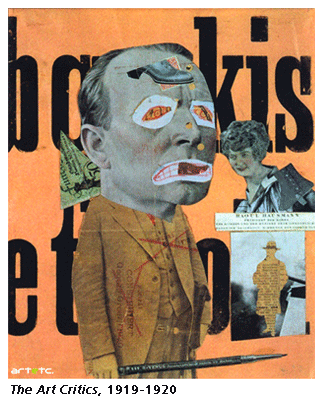 "It was like a thunderbolt: one could I saw it instantaneously make pictures, assembled entirely from cut-up photographs. Back in Berlin that September, I began to realize this new vision, and I made use of photographs from the press and the cinema." (Hausmann, 1958, Quoted in Dada, Dickerman, National Gallery of Art Washington, 2006 p90). The idea of photomontage indeed worked as a thunderbolt for not only Hausmann but for the entire Berlin Dada group and was later described as the voice of the Dadaists from this part of the world. The idea of his photomontages were extremely different and artistic as compared to the later montages and in every way let out the true self of the artist and helped him demonstrate his carefree, unconstrained self. His works employed the use of several mediums and the montages were a result of the peculiar, irrational yet extremely logical juxtaposition of these varied mediums.
"It was like a thunderbolt: one could I saw it instantaneously make pictures, assembled entirely from cut-up photographs. Back in Berlin that September, I began to realize this new vision, and I made use of photographs from the press and the cinema." (Hausmann, 1958, Quoted in Dada, Dickerman, National Gallery of Art Washington, 2006 p90). The idea of photomontage indeed worked as a thunderbolt for not only Hausmann but for the entire Berlin Dada group and was later described as the voice of the Dadaists from this part of the world. The idea of his photomontages were extremely different and artistic as compared to the later montages and in every way let out the true self of the artist and helped him demonstrate his carefree, unconstrained self. His works employed the use of several mediums and the montages were a result of the peculiar, irrational yet extremely logical juxtaposition of these varied mediums.
To quote in the artist's words “…it embodied our refusal to play the part of the artist. We regarded ourselves as engineers and our work as construction...all the arts and their techniques needed a fundamental and revolutionary change, in order to remain in touch with the life of their epoch." (http://homepage.ntlworld.com/davepalmer/cutandpaste/hausmann.html)
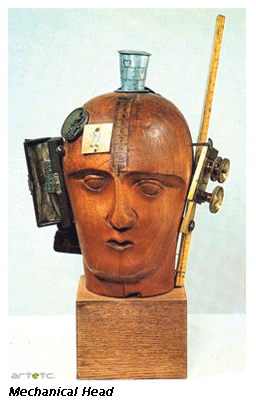
The most well known work by Hausmann, Der Geist Unserer Zeit- Mechanischer Kopf (Mechanical Head [The Spirit of Our Age]), c. 1920, is the only extant assemblage. Constructed from a Hairdresser's wig-making mannequin, the work has an assortment of measuring devices attached to the head, including a ruler, pocket watch mechanism, typewriter, camera segments and a crocodile wallet. Hausmann through this piece of work has tried to revamp and argue the idea of an ideal Head. While according to Hegel and many others, the notion of head is of course of reason and is driven by the fact that everything rests within the mind and every outcome is a result of what lies within. However, the artist discards this notion and tries to pull out the reverse aspect by simply pointing out that whatever sticks to the head defines the thought process and he explains this literally by sticking on the materials to the head. It is the materiality or objectivity of the world that defines the thoughts rather than thoughts residing within the head.
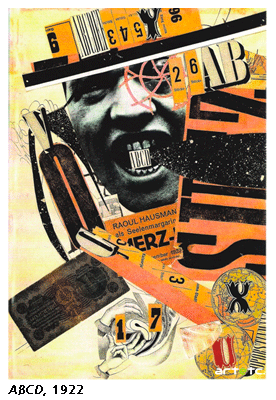
Apart from the Mechanical Head, the other photomontages constructed by the artist drew similar kind of interest and generated almost similar curious responses from the crowd. The montages are indeed a true work of art and have redefined the common and the ordinary. The layering and the textures generated by juxtaposing various materials cut outs express, an inconsistency and is irregular in every way. Nevertheless, the meaning generated from these rough, uneven montages is indeed too underlying and uniform in every way. The self-portrait montage of Hausmann of 1924 is yet another well-known piece of art and is generally referred to as The ABCD. The face of the artist with an open mouth clenching on to the alphabets ABCD is the primary aspect of the montage but the various other elements of the montage from a ticket, an image of a fire extinguisher to one line of a poem presents an underlying more hideous meaning of the montage. The idea behind these works were never to let out the meaning of the works too easily, rather the effort was to hold on to the message and present it subtly and express a more obvious singularity through the unobvious.
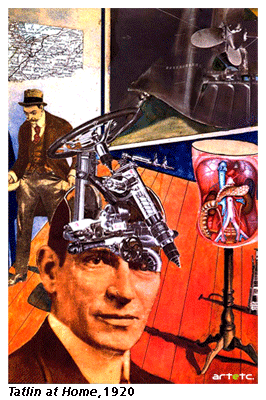
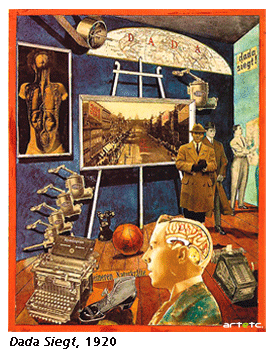 Hausmann, more like his self-portrait has always tried to spell out his discomfort towards the authority and thereby have tried to address his concerns. However, he like many others was always forced to clench on to the words and not express them in the manner they felt. Tatlin at Home, Dada and Dada Siegt produced during 1920 are the other important photomontage works of Raoul Hausmann. 1921 onwards the artist began working on his machine Octophone. This machine was capable of converting audio and visual signals interchangeably. After working to fine-tune this machine and coming up with a manifesto of the same, Hausmann was granted a patent for this machine in the year 1935. Towards the beginning of the 1930s, Hausmann had started reviving himself as a photographer and in the later years, Hausmann exhibited his photographs extensively, concentrating on nudes, landscapes and portraits. In 1942, a photographic montage work of Hausmann was published in Camera and it quite extensively described the obscure life of the artist and his artistic output. More like his photomontages, the idea that he tried to focus on and bring out through his photography was quite similar. The expression was truly Avant Garde and generated a more modernist ideology of protest as compared to the earlier works.
Hausmann, more like his self-portrait has always tried to spell out his discomfort towards the authority and thereby have tried to address his concerns. However, he like many others was always forced to clench on to the words and not express them in the manner they felt. Tatlin at Home, Dada and Dada Siegt produced during 1920 are the other important photomontage works of Raoul Hausmann. 1921 onwards the artist began working on his machine Octophone. This machine was capable of converting audio and visual signals interchangeably. After working to fine-tune this machine and coming up with a manifesto of the same, Hausmann was granted a patent for this machine in the year 1935. Towards the beginning of the 1930s, Hausmann had started reviving himself as a photographer and in the later years, Hausmann exhibited his photographs extensively, concentrating on nudes, landscapes and portraits. In 1942, a photographic montage work of Hausmann was published in Camera and it quite extensively described the obscure life of the artist and his artistic output. More like his photomontages, the idea that he tried to focus on and bring out through his photography was quite similar. The expression was truly Avant Garde and generated a more modernist ideology of protest as compared to the earlier works.
Towards the beginning of the 1940s, Hausmann was forced to flee to Berlin and thereby he started hopping places. Even though he started living a life of isolation then onwards in Paris his, inclination towards art and photography was never quenched out. The artist began reviving his work, started motivating the new generation Dadaist, and thereby worked closely to give shape to books on Photography and sound poems. However, his art forms are still alive and cherished all over the world. The artist left his mortal self on February 1, 1971, in Limoges.
Even though Hausmann and many others were forcefully stopped from speaking the truth but, their annoyance and antagonism towards the war mechanism and the unnecessary Capitalism comes out quite clearly through their works. The ideas generated by these maestros have stood the test of time and helped the world understand and consider them alongside the more obvious prescribed history. The photomontages of Hausmann have not aged with time and they never fail to amaze the world and keep us contemplating over their meaning even today.